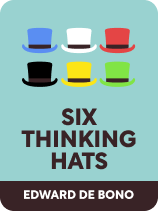

This article is an excerpt from the Shortform book guide to "Six Thinking Hats" by Edward de Bono. Shortform has the world's best summaries and analyses of books you should be reading.
Like this article? Sign up for a free trial here .
What is blue hat thinking in Six Thinking Hats? How and when should you use this hat?
Psychologist Edward de Bono’s blue hat is also known as the metacognition hat. This master hat is usually worn by the leader of a meeting to make sure that the other participants are on staying on track.
Keep reading to learn all about blue hat thinking.
The Blue Hat
The blue hat is the master hat. Blue hat thinking is metacognition, or thinking about thinking. The master hat is the same color as the sky, to symbolize the bird’s-eye view you’re taking of the process when you’re wearing this hat.
For simplicity, usually the chair of the meeting wears the blue hat for the whole meeting—however, participants can also don their blue hats to offer procedural suggestions. The blue hat designs the process, determines the agenda, and monitors the success of the discussion. The blue hat wearer is like an air traffic controller, orchestrating the contributions of the group so that they’re offered and received as smoothly and safely as possible.
The blue hat serves different functions at different stages of the process. Before the discussion, the blue hat offers plans, agendas, and a clear focus. During the discussion, the blue hat prompts and monitors contributions to make sure that everyone is on track. After the discussion, the blue hat collects the outputs and compiles them into a report, executive summary, or other communication.
Blue Hat Questions
While wearing the blue hat, consider these questions:
- What exactly are we trying to achieve?
- How should we think about this matter?
- What’s the best sequence of hats to use here?
- How is the thinking process going?
- What have we achieved?
Blue Hat Data
Blue hat data includes planning documents such as agendas, checklists, calendars, and Gantt (project tracking) charts. It also includes final outputs such as reports and overviews.
Blue hat contributions include procedural suggestions, comments on the progress of the discussion, and suggestions for next steps.
Key Blue Hat Concepts
The blue hat monitors where people’s attention is going in a discussion. Are they clearly focused on the task at hand? Are their contributions appropriate to the hat that’s currently in focus? For example, if you’re currently all supposed to be wearing the white hat and someone offers a stinging critique, the blue hat wearer suggests that they hold this criticism until it’s time for the black hat.
“Focus” doesn’t mean that the meeting has to have only one goal. There can be multiple focuses, as long as everyone present is clear on what these are. An effective method is to frame the discussion with one broad objective and several more specific sub-objectives. For example, a meeting could have the broad objective of finding ways to increase customer satisfaction. Sub-objectives could be improving the company website and enhancing customer service in-store. The blue hat role manages the interplay among these three objectives, providing both the freedom to generate creative ideas on a general level and the discipline to stay with the sub-objectives long enough to workshop some specific, useful, practical ideas in these areas.
Probing and Targeting Questions
Asking questions is a powerful way to focus attention. Questions often result in more open-ended, independent thinking than directives do. Consider the following instructions:
- Directive: “Put on your green hat and give me some new ideas on this.”
- Open-ended: “Let’s put on our green hats. What happens if… ?”
The second instruction carries a sense of freedom and potential that the first doesn’t. There’s nothing wrong with direct orders—they might even be preferable in some circumstances—but they prompt a different type of thinking than questions do. Blue hat expertise is knowing when it’s best to ask questions.
Blue hat wearers also need to be clear on the type of questions they’re asking. There are two main types of questions: Probing questions and targeting questions. Probing questions are open. As in fishing, you put your bait on a hook, drop it in the water, and see what shows up (if anything). Targeting questions set up a specific target and aim at it. Targeting questions are usually questions with yes or no answers, questions that have objectively verifiable answers, or questions that set up a few different alternatives and try to identify which is correct.
Examples of probing questions are:
- “What can we do to make sure this new competitor doesn’t interfere with our sales?”
- “How can we manage carbon dioxide emissions internationally?”
Examples of targeting questions are:
- “What does the new competitor provide that we don’t?”
- “What measures are currently in place to manage carbon dioxide emissions? Are they working?”
Breaking Down Problems
Most problem-solving meetings start with a large, amorphous problem. To discuss this problem properly, it helps to break down the high-level problem into small pieces that can be solved more easily. The blue hat wearer decides exactly which sub-problems will be addressed and in which order.
Examples of sub-problems might be:
- “List some ways we can find out whether our customers are happy.”
- “Give this new product the black hat treatment.”
- “What are our next steps from here?”
It’s also the job of the blue hat to acknowledge when little progress has been made on a sub-problem. The blue hat wearer should acknowledge this openly (“OK, we don’t seem to be getting anywhere on this and I’d like to move on”) and decide whether to continue or to shelve the issue temporarily or permanently.
How to Use the Blue Hat
- The blue hat isn’t limited to determining and monitoring the use of the other hats. Any discussion of strategy, goals, and procedures is blue hat work.
- You can put on your blue hat at any point. If you feel that the procedure could be improved, or would like to suggest a change of hat, put on your blue hat and ask for this. For example: “Putting on my blue hat for a second, it seems to me that there are some strong unacknowledged feelings here. Perhaps we should all put on our red hats and get them out into the open.”
Advice for Facilitators
- Blue hat thinking fits most naturally at the start and end of a discussion, though you may need to cycle back to it if the discussion strays off track. The first blue hat period is concerned with framing the topic clearly, setting goals for the session, and planning the sequence of hats to be used. The final blue hat period is concerned with creating an overview of the discussion that just took place, finalizing any decisions that remain outstanding, and determining what further action needs to be taken and by whom.
- You can ask for a hat-based task to be done directly in the meeting: “Salim, put on your red hat and give me your strongest emotion on this proposal.” Or you can assign a task to be done after the meeting, individually or in a group: “Ying Ren and Howard, please take this proposal away and yellow hat it together. I’ll meet with you both tomorrow.”
- Blue hat thinking is a specific skill, and sometimes people who are excellent at leading other types of meetings are not naturals at wielding the blue hat. If you usually lead meetings but are not very confident or skilled with the blue hat, consider allocating the role to someone else.
Exercise: Try on the Blue Hat
Create a draft meeting agenda or thinking plan based on the six hats.
- Write down either: (1) a problem you’re currently facing at work, or (2) a problem outside of work that you think might be amenable to the Six Hats method.
- Consider the function of each of the six hats: The blue hat is for procedure, the white hat is for information, the red hat is for emotion, the black hat is for criticism, the yellow hat is for constructive thinking, and the green hat is for new ideas.
- Put on your blue hat. Which of the above do you think should be addressed first and why?
- Sketch a plan for the whole thinking process. Remember to touch on each hat at least once. Feel free to circle back to important hats as many times as you like.

———End of Preview———
Like what you just read? Read the rest of the world's best book summary and analysis of Edward de Bono's "Six Thinking Hats" at Shortform .
Here's what you'll find in our full Six Thinking Hats summary :
- A handbook for training people to think more efficiently and productively
- An explanation of each of the six thinking hats created by Edward de Bono
- How to calm your inner critic and dramatically cut your decision-making time






